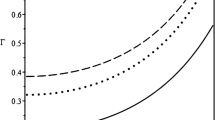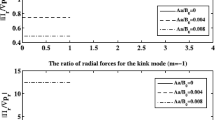Abstract
The possibility of feedback suppression of the external kink modes in a tokamak with a resistive wall is studied theoretically, assuming that the stabilizing conductors are located at a certain distance from the wall and without making any assumptions regarding the locations of the magnetic sensors that close the feedback circuit and the parameters (i.e., the particular components of the perturbed magnetic field or magnetic fluxes) measured by the sensors. It is shown that the efficiency of the stabilizing system can generally be analyzed within a two-parameter model. The parameters of the problem are the jump in the logarithmic derivative of the radial magnetic field in the region where the stabilizing conductors are positioned and the ratio of the minor radius of the torus on which the conductors are wound to the radius of the wall. However, specific calculations should be carried out with at least a three-parameter model: the final results should depend on the currents in the conductors and the locations of the conductors and magnetic sensors. The relation between the magnetic parameter in the criterion for the suppression of the resistive wall modes and the currents in the stabilizing conductors is clarified, and the current magnitudes required for the suppression are estimated.
Similar content being viewed by others
References
A. B. Mikhailovskii and B. N. Kuvshinov, Fiz. Plazmy 22, 188 (1996) [Plasma Phys. Rep. 22, 172 (1996)].
A. B. Mikhailovskii and B. N. Kuvshinov, Fiz. Plazmy 21, 835 (1995) [Plasma Phys. Rep. 21, 789 (1995)].
T. S. Taylor, E. J. Strait, L. L. Lao, et al., Phys. Plasmas 2, 2390 (1995).
Y. Shimomura and V. S. Mukhovatov, private communication.
M. Okabayashi, N. Pomphrey, and R. E. Hatcher, Nucl. Fusion 38, 1607 (1998).
A. D. Turnbull, T. S. Taylor, E. J. Strait, et al., in Proceedings of 15th International Conference on Plasma Physics and Controlled Nuclear Fusion Research, Seville, 1994 (IAEA, Vienna, 1995), Vol. 1, p. 705.
B. N. Kuvshinov and A. B. Mikhailovskii, Fiz. Plazmy 22, 490 (1996) [Plasma Phys. Rep. 22, 446 (1996)].
A. I. Morozov and L. S. Solov'ev, in Reviews of Plasma Physics, Ed. by M. A. Leontovich (Gosatomizdat, Moscow, 1963; Consultants Bureau, New York, 1966), Vol. 2.
Author information
Authors and Affiliations
Additional information
__________
Translated from Fizika Plazmy, Vol. 26, No. 6, 2000, pp. 511–518.
Original Russian Text Copyright © 2000 by Mikhailovskii, Pustovitov.
Rights and permissions
About this article
Cite this article
Mikhailovskii, A.B., Pustovitov, V.D. Feedback suppression of resistive wall modes in a tokamak. Plasma Phys. Rep. 26, 477–483 (2000). https://doi.org/10.1134/1.952881
Received:
Issue Date:
DOI: https://doi.org/10.1134/1.952881




